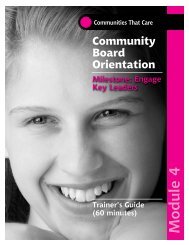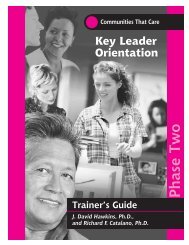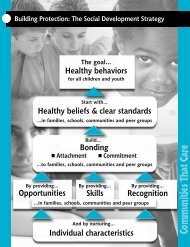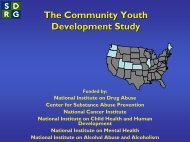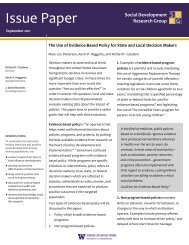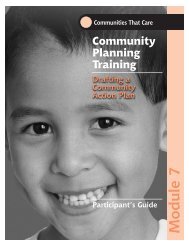CTC Fact Sheet - Social Development Research Group
CTC Fact Sheet - Social Development Research Group
CTC Fact Sheet - Social Development Research Group
You also want an ePaper? Increase the reach of your titles
YUMPU automatically turns print PDFs into web optimized ePapers that Google loves.
Communities That Care (<strong>CTC</strong>)<strong>CTC</strong> is a coalition-based community prevention operating system that uses a public health approach toprevent youth problem behaviors including underage drinking, tobacco use, violence, delinquency, schooldropout and substance abuse.Program Targets:Ultimately, the beneficiaries of <strong>CTC</strong> are children of any age in the community. <strong>CTC</strong> helps decision-makersin the community select & implement tested, effective prevention policies and programs to address themost pressing risks facing their youth. <strong>CTC</strong> guides the community coalition through an assessment andprioritization process that identifies the risk and protective factors most in need of attention, and linksthose priorities to prevention programs that are proven to work in addressing them.Program Content:<strong>CTC</strong> activities are planned and carried out by the <strong>CTC</strong> Community Board, a prevention coalition ofcommunity stakeholders who work together to promote positive youth outcomes. Board membersparticipate in a series of six <strong>CTC</strong> training workshops in which they build their coalition and learn the skillsneeded to install the <strong>CTC</strong> system.Communities That Care is installed in a community through a five-phase process implemented over a 1-2year period:1) Get Started—assessing community readiness to undertake collaborative prevention efforts;2) Get Organized—getting a commitment to the <strong>CTC</strong> process from community leaders and forming adiverse and representative prevention coalition;3) Develop a Profile—using epidemiologic data to assess prevention needs;4) Create a Plan—choosing tested and effective prevention policies, practices, and programs basedon assessment data; and5) Implement and Evaluate—implementing the new strategies with fidelity, in a manner congruentwith the programs’ theory, content, and methods of delivery, and evaluating progress over time.Core components include: Community coalition of key stakeholders concerned with the health and well-being of thecommunity’s youth Community coordinator, preferably full-time devoted to <strong>CTC</strong> but at minimum half time Series of 6 <strong>CTC</strong> trainings (all materials are available on the CSAP webpage free of charge) Certified <strong>CTC</strong> trainers to conduct the trainings <strong>CTC</strong> Youth Survey, administered at least every two years for students in grades 6, 8, 10, and 12,to learn directly from the youth themselves about risk factors, protective factors, and youthbehaviorsProgram Outcomes:Results from a 7-state experimental trial involving 24 communities show that within 4 years of adopting the<strong>CTC</strong> system, community coalitions can reduce the incidence of delinquent behaviors and of alcohol,tobacco, and smokeless tobacco use as well as the prevalence of alcohol use, binge drinking, smokelesstobacco use, and delinquent behavior among young people community wide by the spring of grade 8.Among youths consented into a longitudinal panel in 5 th and 6 th grades, these significant effects of <strong>CTC</strong>were found by spring of grade 8:
‣ Exposure to targeted risk factors increased less rapidly in <strong>CTC</strong> than in control communities.‣ Initiation of substance use and delinquency: By the end of 8 th grade, compared to studentsin the control communities, students from <strong>CTC</strong> communities were:• 24% less likely to initiate delinquent behavior• 32% less likely to initiate the use of alcohol• 33% less likely to initiate cigarette use• 33% less likely to initiate the use of smokeless tobacco‣ Substance use: By 8 th grade, compared to students in the control communities, studentsfrom <strong>CTC</strong> communities were:• 23% less likely to use alcohol in the past 30 days• 49% less likely to use smokeless tobacco in the past 30 days• 37% less likely to have engaged in binge drinking in the past two weeks‣ Delinquent behaviors: In 8 th grade, students from <strong>CTC</strong> communities committed 31% fewerdifferent delinquent behaviors than students in the control communities.Program Costs:All <strong>CTC</strong> training materials are available for download free of charge from CSAP’s Prevention Platform athttp://communitiesthatcare.net/. Installing the <strong>CTC</strong> system requires an on-site community coordinator tomanage the <strong>CTC</strong> coalition; administration, analysis and reporting of the <strong>CTC</strong> Youth Survey; and trainercosts for the six <strong>CTC</strong> trainings. Additionally, communities need to cover the costs of the preventionprograms selected for implementation through the <strong>CTC</strong> process.The information for this fact sheet was excerpted from:Hawkins, J.D., Brown, E.C., Oesterle, S., Arthur, M.W., Abbott, R.D., & Catalano, R.F. (2008). Early effects of Communities That Care on targetedrisks and initiation of delinquent behavior and substance use. Journal of Adolescent Health, 53, 15-22.Hawkins, JD, Oesterle, S, Brown, EC, Arthur, MW, Abbott, RD, Fagan, AA, & RF Catalano. (2009). Results of a type 2 translational research trial toprevent adolescent drug use and delinquency: A test of Communities That Care. Archives of Pediatrics and Adolescent Medicine.For more information and materials:Blair Brooke-WeissCommunities That Care Specialistbbrooke@uw.edu(206) 543-5709<strong>Social</strong> <strong>Development</strong> <strong>Research</strong> <strong>Group</strong>School of <strong>Social</strong> WorkUniversity of Washington9725 3rd Avenue NE, Suite 401Seattle, WA 98115(206) 543-4507 -FAXwww.sdrg.orghttp://ncadi.samhsa.gov/features/ctc/resources.aspxBranch Chiefpatricia.getty@samhsa.hhs.gov(240) 276-2577Division of Systems <strong>Development</strong>Center for Substance Abuse PreventionSubstance Abuse & MentalHealth Services Admin.One Choke Cherry Road, #4-1027Rockville, MD 20857(240) 276-2580 (FAX)Patricia Getty, Ph.D.





